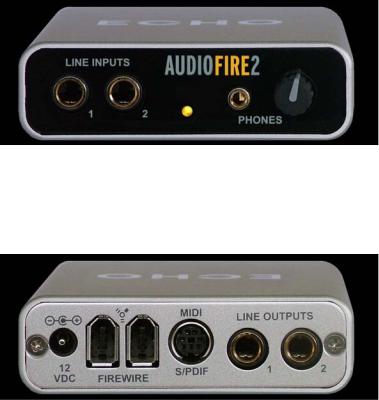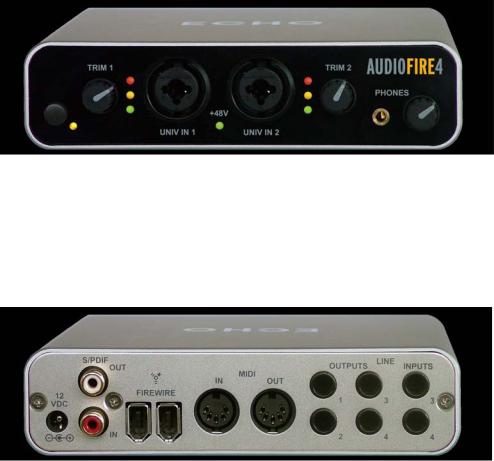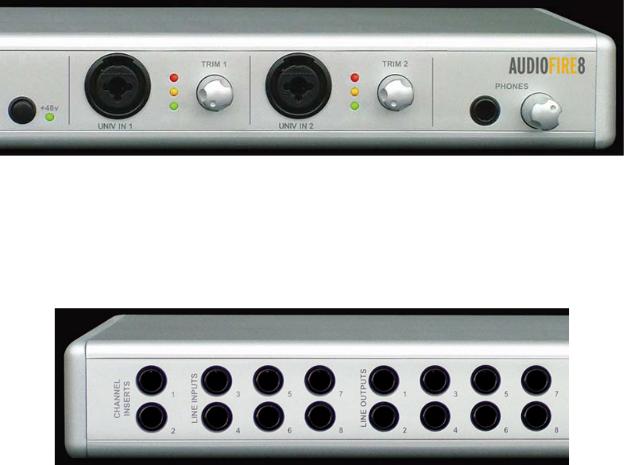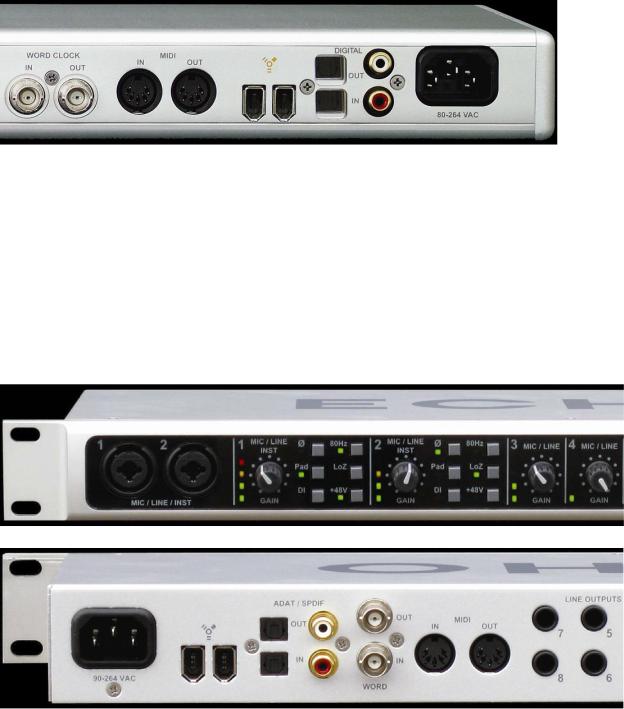Echo AUDIOFIRE2, AUDIOFIRE4, AUDIOFIRE8, AUDIOFIREPre8, AUDIOFIRE12 Owner’s Manual
AUDIOFIRE2TM
AUDIOFIRE4TM
AUDIOFIRE8TM
AUDIOFIREPre8TM
AUDIOFIRE12TM

Owner’s Manual Version 2.2 for Windows
Important Safety Instructions
1.Read Instructions – Be sure to read all of the safety and operating instructions before operating this product.
2.Retain Instructions – The safety instructions and owner's manual should be retained for future reference.
3.Heed Warnings – All warnings on your Echo product and in the Owner's Manual should be followed.
4.Follow Instructions – All operating and use instructions should be followed.
5.Moisture – Water and moisture are detrimental to the continued good health of your Echo product. Do not install or operate your Echo product near sources of water or moisture such as sinks, damp basements, leaky roofs, etc.
6.Heat – Your Echo product should be situated away from sources of heat such as heaters or radiators.
7.Power Sources – This unit should be operated only from the type of power source indicated in this documentation or on your Echo product. If you are unsure about the type of power at your location, contact your local power company.
8.Grounding – Precautions should be taken so that the grounding capabilities of the unit are not undermined. The AudioFire 8, AudioFire Pre8 and AudioFire 12 are provided with a cord with an equipment grounding conductor and grounding plug. This plug must be plugged into an outlet that is properly installed and grounded in accordance with all local rules and ordinances. Do not modify the plug provided with the equipment. If the plug will not fit into your outlet, have a proper outlet installed by a qualified electrician.
9.Power Cord Protection – Power supply cords should be routed so that they are unlikely to be walked on or pinched by items placed upon or against them. Pay particular attention to protecting the plugs, outlets, and the point at which the cord exits your Echo product.
10.Servicing – Do not attempt to service this unit yourself, as opening the case will expose you to hazardous voltage or other dangers. All servicing should be referred to qualified service personnel.
11. Damage Requiring Service – Unplug this unit and refer it to a qualified service technician when any of the following occur:
a)Objects have fallen or liquid has spilled into the unit
b)The product has been exposed to rain or water
c)The product does not operate normally or when a marked change in performance is noticed
d)The product has been dropped or damaged in any way
Registering your product online at http://www.echoaudio.com/support/register.php allows us to register key information so that we may handle problems faster and inform you of advance information on upgrades and other news. Thank you in advance for registering. We hope you enjoy your Echo product.
Limited Warranty
Echo Digital Audio Corporation warrants this product, when purchased at an Authorized Echo Dealer in the United States of America, to be free of defects in materials and manufacturing workmanship for a period of one year from the date of original purchase. During the warranty period Echo shall, at its option, either repair or replace any product that proves to be defective upon inspection by Echo. Final determination of warranty coverage lies solely with Echo. Echo reserves the right to update any unit returned for repair, and reserves the right to change or improve the design of the product at any time without notice.
This is your sole warranty. Echo does not authorize any third party, including any dealer or sales representative, to assume any liability on behalf of Echo or to make any warranty for Echo.
Service and repairs of Echo products are to be performed only at the factory (see below) unless otherwise authorized in advance by the Echo Service Department. Unauthorized service, repair or modification will void this warranty.
To obtain factory service:
Contact Echo Digital Audio Corporation at (805) 684-4593, 9AM to 4PM Monday through Friday (Pacific Time). If necessary, you will be given a return authorization number. Products returned without an RA number will be refused. Echo may, at its option, require proof of the original date of purchase in the form of a dated copy of the original authorized dealer’s invoice or sales receipt. Pack the product in its original shipping carton and attach a description of the problem along with your name and a phone number where Echo can contact you if necessary. Ship the product insured and freight prepaid to:
Echo Digital Audio Corporation
6450 Via Real
Carpinteria, CA 93013
DISCLAIMER AND LIMITATION OF WARRANTY
Echo makes no other warranties, express, implied, or otherwise, regarding Echo products, and specifically disclaims any warranty for merchantability or fitness for a particular purpose. The exclusion of implied warranties is not permitted in some states and the exclusions specified herein may not apply to you. This warranty provides you with specific legal rights. There may be other rights that you have which vary from state to state.
In no event will Echo be liable for any lost profits, or for any consequential, direct or indirect damages, however caused and on any theory of liability, arising from this warranty and sale.
©2009 by Echo Digital Audio Corporation 6450 Via Real
Carpinteria, CA 93013
Echo® and AudioFire™ are trademarks of Echo Digital Audio Corporation.
FireWire® is a trademark of Apple Computer, Inc.
Windows®, Windows XP®, Windows Vista® and Windows 7® are registered trademarks of Microsoft, Inc.
INTRODUCTION.................................................................................................... |
9 |
WHAT YOU SHOULD HAVE RECEIVED IN THE BOX ................................................. |
9 |
SYSTEM REQUIREMENTS ....................................................................................... |
10 |
INSTALLATION ................................................................................................... |
11 |
LOG IN AS ADMINISTRATOR .................................................................................. |
11 |
IMPORTANT — CHECK THE ECHO WEBSITE FOR SOFTWARE UPDATES ................. |
11 |
INSTALLING THE AUDIOFIRE HARDWARE AND SOFTWARE ................................... |
12 |
CONNECTING TO THE AUDIO INTERFACE............................................................... |
14 |
CONSOLE .............................................................................................................. |
25 |
RUNNING THE CONSOLE........................................................................................ |
25 |
AUTOMATIC FLASH UPDATE ................................................................................. |
25 |
CONSOLE WINDOW ............................................................................................... |
25 |
BUS SELECT TABS................................................................................................. |
26 |
MASTER OUTPUT BUS CONTROL........................................................................... |
27 |
PLAYBACK CONTROLS .......................................................................................... |
27 |
ANALOG INPUTS.................................................................................................... |
28 |
DIGITAL INPUTS (AUDIOFIRE 2, AUDIOFIRE 4, AUDIOFIRE 8 AND AUDIOFIRE |
|
PRE8) .................................................................................................................... |
30 |
Adjusting Playback Volume ............................................................................. |
31 |
Nominal Levels................................................................................................. |
32 |
SETTINGS TAB....................................................................................................... |
32 |
Sample Rate in XP............................................................................................ |
33 |
Core Audio Sample Rate - Windows Vista/Windows 7.................................... |
34 |
Clock Source .................................................................................................... |
34 |
Digital Mode (AudioFire 8 and AudioFire Pre8)............................................ |
34 |
S/PDIF Format ................................................................................................ |
35 |
Wave Devices ................................................................................................... |
35 |
Buffer Size ........................................................................................................ |
35 |
ABOUT DIALOGUE BOX......................................................................................... |
36 |
Version Information ......................................................................................... |
36 |
Copy Version Information to Clipboard.......................................................... |
36 |
Flash Update.................................................................................................... |
37 |
AUDIOFIRE 2 AND AUDIOFIRE 4 PLAYBACK ROUTING.......................................... |
37 |
SYSTEM TRAY ICON .............................................................................................. |
38 |
CONSOLE SESSIONS............................................................................................... |
39 |
CONSOLE SETTINGS AND STAND-ALONE MODE.................................................... |
39 |
CORE AUDIO ......................................................................................................... |
40 |
ASIO AND WINDOWS VISTA/WINDOWS 7............................................................. |
41 |
SURROUND SOUND PLAYBACK.............................................................................. |
41 |
Stereo versus surround sound modes............................................................... |
41 |
Windows XP configuration .............................................................................. |
42 |
Windows Vista/Windows 7 configuration........................................................ |
42 |
Application configuration ................................................................................ |
42 |
MULTI-CLIENT AUDIO ........................................................................................... |
43 |
FIREWIRE ANALYZER ........................................................................................... |
44 |
Status................................................................................................................ |
44 |
Playback........................................................................................................... |
44 |
Record .............................................................................................................. |
44 |
ASIO wakeup.................................................................................................... |
45 |
ASIO host ......................................................................................................... |
45 |
Firmware.......................................................................................................... |
45 |
Buffer offset ...................................................................................................... |
46 |
Things to watch for .......................................................................................... |
46 |
Saving a report................................................................................................. |
46 |
CONTACTING ECHO CUSTOMER SERVICE .............................................. |
50 |
APPENDIX A: GENERAL TROUBLESHOOTING GUIDE .......................... |
51 |
APPENDIX B: AUDIO SOFTWARE GUIDE................................................... |
55 |
APPENDIX C: AN INTRODUCTION TO DIGITAL RECORDING............. |
56 |
INDEX..................................................................................................................... |
63 |
Introduction
Introduction
Thank you for choosing Echo Digital Audio. We think you’ll find your Echo product to be an extremely flexible, high-performance tool for your computerbased hard disk recording system.
What You Should Have Received in the Box
When you opened the box, you should have found the following:
•An audio interface box
•Four mounting screws with collars (AudioFire 8, AudioFire Pre8 and AudioFire 12 only)
•Two removable rack-mount brackets (AudioFire 8 only)
•A FireWire cable
•A MIDI and S/PDIF dongle (AudioFire 2 only)
•A 4-pin to 6-pin FireWire adapter (AudioFire 2 and AudioFire 4 only)
•A power cable or power adapter
•A CD-ROM containing:
•Windows XP and Vista/Windows 7 Drivers
•Mac OS X Drivers
•PDF Owner’s Manual
.
• A Quick Start Guide
9
Introduction
Introduction
System Requirements
In order to use AudioFire 2, AudioFire 4, AudioFire 8, AudioFire Pre8 or AudioFire 12 you’ll need the following:
•A desktop or laptop computer with:
•Windows XP Service Pack 3 or newer operating system
•An unused FireWire port
•A minimum 256Mb of RAM (512Mb highly recommended)
•A fast, high-capacity IDE, SATA, or FireWire hard disk drive
•Peripheral audio equipment, such as a mixer, microphones, studio monitors, musical instruments, etc.
10
Introduction
Installation
Installation
Complete installation consists of logging in as an administrator, installing the Windows drivers into your system, connecting the audio interface to a FireWire port and then connecting your AudioFire to any other peripheral audio equipment.
Log In as Administrator
To install your Echo product you must be logged into your computer as an Administrator. You can either log in with the account called “Administrator” or with any other account that has administrative privileges. Otherwise, you will not be able to install the hardware and drivers.
Important — Check the Echo Website for Software Updates
You should always check our website (www.echoaudio.com) for the latest driver updates before installing your AudioFire product. Just go to the driver downloads area and find the AudioFire section. If there is a new driver then you should use it instead of the one on the AudioFire CDROM. Just compare the version number to the version shown on the AudioFire CDROM installation screen to be sure. You should also check the website periodically in the future in case new drivers are released at a later date.
11
Installation
Installation
Installing the AudioFire Hardware and Software
Now that you have logged in as an administrator you are ready to install your AudioFire product in your computer.
1.Install the drivers. You should do this before connecting the AudioFire interface to the FireWire port on your computer. Insert the AudioFire Install CD-ROM into your machine. The main install window should automatically appear. If it does not, simply go to “My Computer,” and double-click on your CD-ROM drive icon. Now, select “Install AudioFire Driver,” and follow the on-screen directions. If you found a newer driver on our website, then you will want to install that instead of the one on the AudioFire CDROM. (To install the downloaded driver, double-click on the icon and follow the instructions.)
2.Once you have installed the Windows driver, locate the audio interface box, the power cable or power adapter, and the FireWire cable. If you are installing an AudioFire 8, AudioFire Pre8 or AudioFire 12, securely mount the interface into your equipment rack. If you will not be mounting the box in a rack, then be sure to place the interface box in a secure location.
3.If you have AudioFire 8, AudioFire Pre8 or AudioFire 12, plug the power cable firmly into the interface and a power socket, and then turn on the interface by pressing the power button. If you have AudioFire 2 or AudioFire 4 and your computer’s FireWire port has a 6-pin connector, your AudioFire can be powered directly through FireWire. No external power supply is needed. If your computer’s FireWire port has a 4-pin connector or if you use your AudioFire in stand-alone mode, plug the included power adapter firmly into the interface and a power socket.
4.Plug one end of the FireWire cable into the FireWire connector on the rear of the AudioFire interface. Attach the other end of the FireWire cable to an open FireWire port on your computer. (If the connector does not match the port on your computer then you will need to get an adapter – included with the AudioFire 2 and AudioFire 4.)
12
Installation
Installation
5.Windows should find new hardware called “AudioFire” and begin to install the drivers. You should select the options “No, not this time,” “Install the software automatically,” and then click the “Continue anyway” and “Finish” buttons.
This is done automatically in Vista/Windows 7.
Note: Microsoft has not digitally signed this version of the WDM driver. You will need to confirm that you want to install an unsigned driver in Windows XP. The Driver has been signed for Windows Vista/Windows 7.
6.You can now attach external audio devices to the connectors on the AudioFire interface box. Information on attaching external devices to the audio interface box may be found in the following section: “Connecting to the Audio Interface”.
7.Next, run the AudioFire Console. The console is located in the Start Menu under Echo Digital Audio and AudioFire. The first time you run the console, it will check that your AudioFire has the latest firmware. If it doesn’t, click “Yes” to flash the latest firmware. IMPORTANT — Do not turn off or unplug your AudioFire while the firmware is being flashed! Once the firmware update is complete you will need to reboot your AudioFire to load the new flash.
13
Installation

Connecting to the Audio Interface
Connecting to the Audio Interface
The AudioFire 2, AudioFire 4, AudioFire 8, AudioFire Pre8 and AudioFire 12 audio interfaces contain a wide variety of connections that allow great flexibility in operation. For optimal performance, it is critical to use the appropriate cabling and connectors.
Analog Inputs and Outputs – AudioFire 2
AudioFire 2’s front panel has two analog line inputs (1 – 2), an amber power indicator light, and an 1/8” stereo headphone output jack, with a corresponding volume knob, which monitors analog outputs 3 and 4, labeled “Headphones” in the AudioFire Console. The analog inputs operate with an input impedance of 10Kohms.
AudioFire 2 has two analog line outputs on the rear panel. The input and output connections can be used with balanced or unbalanced cables via the ¼” connectors. By default, the inputs and outputs are set to receive or send a +4dBu signal.
You can switch between +4dBu and –10dBV for each individual input and output via the console software (see section below).
14
Connecting to the Audio Interface

Connecting to the Audio Interface
Analog Inputs and Outputs – AudioFire 4
AudioFire 4’s front panel has two universal inputs (1 – 2) with meters and trim knobs, a phantom power indicator (+48v), and a power button with an amber power indicator light. There is also an 1/8” stereo headphone output jack, with a corresponding volume knob, which monitors analog outputs 1 and 2.
AudioFire 4 has two analog line inputs (3 – 4) and four analog line outputs on the rear panel. These analog inputs (3 – 4) operate with an input impedance of 10Kohms. The input and output connections can be used with balanced or unbalanced cables via the ¼” connectors. By default, the inputs and outputs are set to receive or send a +4dBu signal.
You can switch between +4dBu and –10dBV for each individual input and output via the console software (see section below).
Analog Inputs and Outputs – AudioFire 8
AudioFire 8’s front panel has two universal inputs (1 – 2) with meters and trim knobs, a phantom power switch and light (+48v), and a power button with an amber power indicator light (not shown below). There is also a ¼” stereo
15
Connecting to the Audio Interface

Connecting to the Audio Interface
headphone output jack, with a corresponding volume knob, which monitors analog outputs 1 and 2.
AudioFire 8 has six analog line inputs (3 – 8) and eight analog line outputs on the rear panel. These analog inputs (3 – 8) operate with an input impedance of 10Kohms. The input and output connections can be used with balanced or unbalanced cables via the ¼” connectors. By default, the inputs and outputs are set to receive or send a +4dBu signal.
You can switch between +4dBu and –10dBV for each individual input and output via the console software (see section below). There are also two channel inserts on the rear panel where you can connect a serial effects device (compressor, EQ, etc.) for the universal inputs (1 – 2). The channel inserts are wired: tip = send, ring = return and sleeve = ground.
16
Connecting to the Audio Interface

Connecting to the Audio Interface
The new AudioFire 8 (as of July 2009) now has optical S/PDIF and ADAT I/O, in addition to coaxial S/PDIF.
Analog Inputs and Outputs – AudioFire Pre8
AudioFire Pre8’s front panel has two universal inputs (1 – 2) with meters and trim knobs. Inputs 1 – 2 also have Phase, 80Hz, Pad, LoZ, DI and phantom power buttons with corresponding LEDS. In addition, there are six meters and trim knobs on the front panel for universal inputs (3-8) and a corresponding phantom power button and LED. There are also two ¼” stereo headphone output jacks wired in parallel which monitor analog outputs 1 and 2 with a corresponding volume knobs, the main volume control (Outputs 1 – 2) and the On/Off button and LED.
17
Connecting to the Audio Interface

Connecting to the Audio Interface
The rear panel has universal inputs 3 – 8, line outputs 1 – 8, 2 channel inserts, MIDI i/o, S/PDIF i/o, ADAT i/o, BNC WordClock connectors, and two FireWire connectors.
AudioFire Pre8 Analog Inputs 1 – 2 Microphone and Line Buttons
Analog inputs 1 – 2 each have 6 associated buttons: Phase, 80Hz, Pad, LoZ, DI and +48V (phantom power).
Microphone buttons:
Ø (Phase): Inverts the polarity of the signal. Useful for miking drums, etc.
80Hz: Turns on an 80Hz high pass filter to reduce low frequency rumble and hum.
Pad: Reduces the preamp gain by 20dB to accommodate large microphone or line level signals connected via XLR.
LoZ: Reduces the microphone preamp input impedance from 3,000 ohms to 1,000 ohm. Some microphones are designed to drive a lower impedance and will sound better when this switch is on.
+48V: Turns on phantom power.
Line button:
DI: Direct input. Increases the 1/4" input impedance from 12,000 ohms to 1 meg ohm. Useful for connecting electric guitars or other instruments needing a high input impedance. Should only be used with mono plugs.
18
Connecting to the Audio Interface
Connecting to the Audio Interface
Universal Inputs – AudioFire 4, AudioFire 8 and AudioFire Pre8
The universal input connections can accept balanced or unbalanced signals via ¼” or XLR connectors. Since your AudioFire has built-in preamps, you can just plug your microphone or guitar cable right into the universal input. No external preamp, direct box, or mixer is needed!
To use a microphone, plug the microphone’s XLR cable into any of the universal inputs. Whenever an XLR cable is connected to a universal input, the microphone preamp is enabled and the gain range of the trim knob is set to range from +10 to +59dB. The input impedance of each microphone preamp is 1.5Kohms. Full-scale input is 9dBu with the trim set to minimum gain.
Your AudioFire provides 48 volts of phantom power for microphones that require it. On AudioFire 4, to enable phantom power, press the button labeled +48v in the AudioFire Console (the +48V LED will light up) and phantom power will be provided to all microphone inputs. On AudioFire 8 and AudioFire Pre8, to enable phantom power, press the button labeled +48v on your audio interface box (the LED next to it will light up) and phantom power will be provided to all selected microphone inputs.
Note: Phantom power will not be applied to any line level equipment or guitars plugged in using cables with ¼” connectors.
To record a guitar or line level signal, just plug a cable with a ¼” connector into one of the universal inputs. Whenever a ¼” cable is connected to a universal input, the guitar/line preamp is enabled and the gain range of the trim knob is set to range from 0 to +45 dB. The guitar/line preamp can support both guitar & line level signals. The input impedance of each guitar/line preamp is 102Kohms. Full-scale input is 18dBu with the trim set to minimum gain.
If you want to adjust the input level of a universal input, just turn the trim knob and watch the corresponding level meter. The red light at the top will light anytime the input signal is greater than –6.5dBFS (or within 6.5dB of clipping). The yellow light represents a signal greater than –12.5dBFS, and the green light represents a signal greater than –36.5dBFS.
19
Connecting to the Audio Interface
